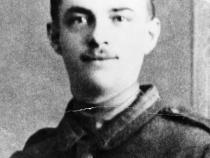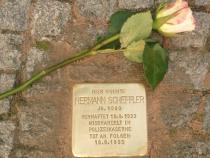Location
Demminer Str. 13
District
Gesundbrunnen
Stone was laid
September 2008
Born
12 February 1893 in Königsberg i. d. Neumark / Chojna
Occupation
Tischler / Stadtverordneter
Murdered
19 September 1933 in Berlin, Polizeikaserne Chausseestr.
On 19th September [1933], I received notification from the local police station that my husband had died. I was given the address of the mortuary and applied for the body to be released. I saw my husband's body in the mortuary and noticed that his left hand had been torn off and there were wounds on his right hand. He also had stab wounds on his head and his main artery had been pierced. I was harassed several times after my husband's death. My house was searched for incriminatory material at all times of the day and night. But nothing was ever found.
Erna Scheffler, 1946
Hermann Scheffler, a carpenter, joined the USPD in 1919 and went over to the KPD in 1920. In the 1920s he worked as a moulder for the Deutsche Werke in Spandau, where he became a member of the works council. He was also active in the KPD's Militärapparat group, which was set up to prepare an armed uprising. In 1925, he was elected to Wedding council. He spent two years living in the Soviet Union, 1930 - 1932. He was a regional leader of the RFB (Red Front Fighters' League), which had been banned in 1929. When he returned to Germany, he worked for the Berlin public transport services but was dismissed in 1933, most probably for political reasons. On 18.9.1933, he was arrested by members of the SA. A fellow communist who was arrested with him later reported on what happened in the ensuing hours: As soon as we got to the police station in Zingster Strasse we were both outrageously beaten up. The same thing happened several times at Wedding police station and so badly that Scheffler, who was in the same room as me, repeatedly broke down. I was told to fetch some water and pour it on him. He came to but broke down in front of my eyes and was carried out by the police. I had the impression that Scheffler had died before my eyes. I can see why the death certificate says internal bleeding because I witnessed Scheffler literally being beaten to death. In 1947, a street in Hohen-Neuendorf near Berlin was named after Hermann Scheffler.
Hermann Scheffler was a city councillor 1929 - 1931, Constituency 3 Wedding (KPD)
Erna Scheffler, 1946
Hermann Scheffler, a carpenter, joined the USPD in 1919 and went over to the KPD in 1920. In the 1920s he worked as a moulder for the Deutsche Werke in Spandau, where he became a member of the works council. He was also active in the KPD's Militärapparat group, which was set up to prepare an armed uprising. In 1925, he was elected to Wedding council. He spent two years living in the Soviet Union, 1930 - 1932. He was a regional leader of the RFB (Red Front Fighters' League), which had been banned in 1929. When he returned to Germany, he worked for the Berlin public transport services but was dismissed in 1933, most probably for political reasons. On 18.9.1933, he was arrested by members of the SA. A fellow communist who was arrested with him later reported on what happened in the ensuing hours: As soon as we got to the police station in Zingster Strasse we were both outrageously beaten up. The same thing happened several times at Wedding police station and so badly that Scheffler, who was in the same room as me, repeatedly broke down. I was told to fetch some water and pour it on him. He came to but broke down in front of my eyes and was carried out by the police. I had the impression that Scheffler had died before my eyes. I can see why the death certificate says internal bleeding because I witnessed Scheffler literally being beaten to death. In 1947, a street in Hohen-Neuendorf near Berlin was named after Hermann Scheffler.
Hermann Scheffler was a city councillor 1929 - 1931, Constituency 3 Wedding (KPD)




